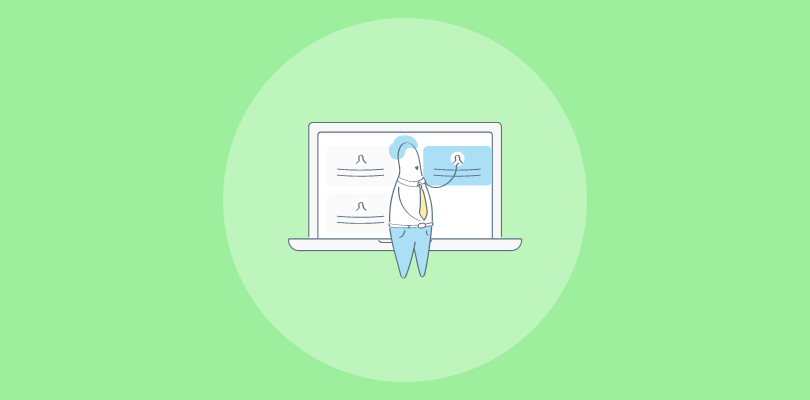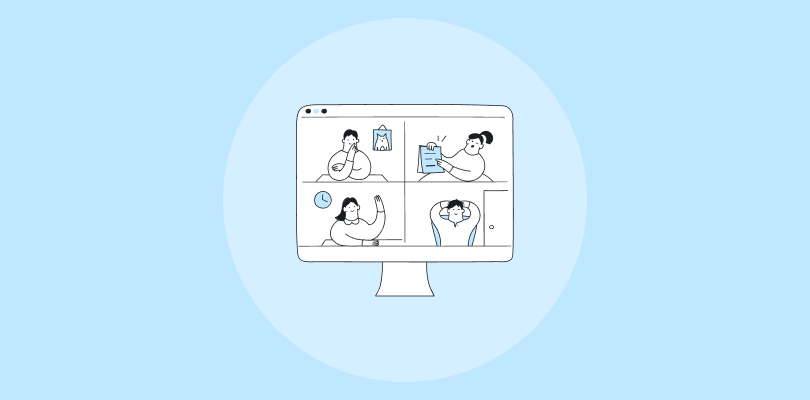Okay, so I tried to host my last webinar in the metaverse.
Long story short, my avatar’s digital suit cost more than my actual webinar budget. Apparently, even virtual coffee requires a premium subscription. Let’s skip the digital disasters and talk about real-world webinar costs; the ones that actually impact your bank account, not just your pixelated persona.
As someone who has hosted, optimized, and analyzed hundreds of webinars, I know expenses add up fast: from software fees to marketing, hidden overage charges, and overpriced equipment. But here’s the good news: you don’t need a massive budget for a high-quality webinar. This guide breaks down where your money goes, what’s worth spending on, and how to maximize your ROI.
Let’s read along to know more.
Key Factors That Influence Webinar Costs
Webinar pricing can be a tricky beast to tackle. Some people assume they can just hop onto a free platform, send out a link, and boom—instant success.
But, if you want a webinar that truly engages your audience, keeps them hooked, and converts them into leads or paying customers, you’ll need to invest in the right tools and strategies.
Let’s go through each factor in detail so you can make smart budgeting decisions and avoid unnecessary expenses.
1. Webinar Platform & Software Costs
Your choice of webinar software is the backbone of your budget. Platforms that are free are great if you’re hosting a casual catch-up, but the moment you need branding, analytics, or audience engagement tools, you’re entering paid territory.
Free vs. Paid Webinar Tools
Free platforms come with a catch—limits on attendees, branding, and (the worst of all) session duration. Ever had a webinar cut off mid-sentence because you hit the free plan’s time limit? That’s awkward!
Real-World Cost Breakdown:
- A basic webinar plan (100 attendees) → $70-$80 per month
- A mid-tier plan (500 attendees) → $300-$350 per month
- Large-scale webinars (1,000+ attendees) → $600+ per month
💡 Cost-Saving Tip: If you are running just one webinar, go for a pay-per-use model, which might be cheaper than a monthly subscription. Always check if there’s a one-time pricing option!
2. Number of Attendees
Webinar hosting costs might scale up with your audience size. It’s like hosting a party—feeding ten guests is manageable, but when the RSVP count hits a thousand, things get pricey.

Attendee-Based Pricing Example:
- Up to 100 attendees → Around $80 per month
- Up to 500 attendees → Roughly $350 per month
- Up to 1,000 attendees → Expect $600+ per month
💡 Budget Trick: Need more reach without extra cost? Simulcast your webinar on YouTube or LinkedIn Live—it’s like sneaking in extra webinar attendees without paying for a bigger room.
3. Features & Functionality
Let’s be real—nobody wants to sit through a dry, lifeless webinar. But the features that keep attendees engaged often come with a price tag.
Paid Features That Can Add Up:
HD Video Streaming – Want crisp, clear visuals? Some platforms charge extra for full HD or 4K.
Interactive Polls & Q&A – More audience engagement, more dollars.
AI-Powered Transcripts & Captions – Great for accessibility, but locked behind premium plans.
Custom Branding – No one wants their webinar to look like a generic template, but full branding options often require an enterprise plan.
Landing Pages & Registrations – Standalone tools cost $30-$50 per month, but some platforms include them in top-tier plans.
💡 Smart Budgeting: Instead of paying for separate tools, look for an all-in-one webinar platform like WebinarNinja. Remember! Bundled pricing usually saves money!
4. Event Duration
Would you pay extra just because your event runs long? In some cases, you might have to!
Pricing Considerations for Duration:
- Short webinars (up to 60 minutes): Usually included in base pricing.
- Longer sessions (2+ hours): Some platforms charge per hour or require an upgraded plan.
💡 Personal Insight: I once ran a four-hour masterclass and ended up paying double because I didn’t realize the free plan had a session time cap. The lesson I learned is that always check session limits in the fine print!
5. Number of Hosts & Speakers
Thinking of hosting a panel discussion? Be prepared, because most platforms charge extra for multiple hosts.
Cost Breakdown:
- Basic plans usually include one host.
- Adding co-hosts? That’ll cost extra, either as a higher-tier plan or an add-on fee.
- Some platforms let you screen-share guest speakers instead of making them official hosts—this can be a sneaky way to save money.
💡 Workaround Hack: Have panelists join as regular attendees and use screen sharing to let them present without paying extra for co-host privileges. Smart, right?
6. Cloud Storage & Webinar Recordings
Recording your webinar? Most platforms offer some free cloud storage, but anything beyond that will cost you.
Cloud Storage Costs:
- Basic free plan → No cloud storage included.
- Mid-tier plan → Typically 1GB of storage.
- Additional storage → Usually $5-$10 per GB per month.
💡 Money-Saving Move: Skip expensive cloud storage—download your recordings and save them on Google Drive, Dropbox, or an external hard drive instead. Some platforms like WebinarNinja offer you unlimited recording and storage at no extra cost.
7. Marketing & Promotion Costs
A great webinar without an audience is just… sad. Unless you have an existing email list, you’ll need to invest in marketing to get attendees.
Possible Expenses:
Paid Ads → Google, Facebook, and LinkedIn ads ($200-$500 per campaign).
Email Marketing Tools → About $20-$50 per month.
Landing Page Builders → $30-$100 per month if using standalone software.
💡 My Go-To Trick: Before spending on ads, leverage social media, partnerships, and your email list—it’s free and often just as effective!
8. Technical Support & Staffing
Big webinars = big potential for technical issues.
If things go south, you’ll need support staff and in some extreme cases trusted technical support companies are needed to handle glitches, audience questions, and troubleshooting.
Additional Costs to Consider:
- Freelance webinar moderators → $20-$50 per hour.
- IT support for troubleshooting → $50-$100 per hour.
- Full-service event management → $500-$1,500 per webinar.
💡 Budget Tip: For smaller events, train your existing team instead of hiring external support—it’s a simple way to cut costs.
9. Customization & Branding
Want your webinar to look and feel like your brand instead of a cookie-cutter template? That’ll cost you.
Branding Costs:
- Basic branding (logo on registration page) → Usually included in mid-tier plans.
- Full white-label branding (custom domains, branded emails, etc.) → Often $200+ per month.
💡 Workaround: If full white-labeling is too pricey, create a branded landing page and direct attendees there instead!
10. Equipment & Production Costs
You can have the best content in the world, but if your audio and video quality are bad, people will check out fast.
Must-Have Equipment & Costs:
🎤 USB Microphone → Good quality starts at $80-$150.
📹 HD Webcam → A solid choice costs $70-$150.
💡 Lighting Setup → A $30 ring light can make a huge difference.
🎬 Editing Software (if needed) → Subscription plans start at $20/month.
💡 Pro Tip: A good microphone matters more than a high-end camera—clear audio keeps people engaged, even if the video isn’t perfect!
What Are the Types of Webinar Costs?
After checking the features and factors that influence webinar costs, let’s check some of major types of webinar costs.
Whether you’re hosting a one-off live webinar or running webinars frequently, understanding how much does a webinar cost and where your money goes helps you budget wisely and avoid unpleasant surprises.
a) One-Time Costs
These are the initial investments you’ll need to make for a professional, high-quality webinar setup. While some people can get by with just a laptop, investing in good equipment improves audience experience, engagement, and overall credibility.
🔹 Equipment Costs – If your audio sounds like you’re talking from inside a cave, no one will stick around. A USB microphone ($80-$200) is the single best investment you can make to ensure clear, professional sound. A decent HD webcam ($70-$150) helps you look polished instead of pixelated.
🔹 Background Setup – If your webinar background includes messy bookshelves, dim lighting, or that random laundry pile (we’ve all been there), consider upgrades like a green screen ($50+), softbox lighting ($30-$100), or a simple backdrop for a more polished and distraction-free look.

🔹 Editing Software – Planning to record and repurpose your webinar? A solid video editing tool ($20/month) helps you create polished on-demand versions for future use. Free options exist, but paid tools often offer better features like AI-powered audio cleanup and automatic captions.
| 💡 Personal Insight: When I first started hosting webinars, I relied on my laptop’s built-in mic and webcam. Big mistake. My voice sounded muffled, and the video was grainy. Upgrading to a USB mic and an external webcam made a night-and-day difference. If you can only invest in one thing, get a good mic—your audience will thank you. |
b) Recurring Costs
These are the ongoing expenses that keep your webinars running month after month. If you’re hosting webinars regularly, these costs add up fast.
- Webinar Software Subscription – Most platforms charge based on the number of attendees and features you need. Basic plans start around $70 per month, while premium plans for large-scale events can exceed $600 per month.
- Email Marketing & CRM – If you’re sending automated invites, reminders, or follow-ups, you’ll likely need an email marketing tool. Expect to spend $20-$100 per month, depending on the size of your email list and automation needs.
- Landing Page Builders – Some webinar platforms include registration pages, but if they don’t, you may need a separate tool. Standalone landing page builders cost around $30-$100 per month.
💡 Budget Tip: If you plan to host multiple webinars per year, paying annually for software and marketing tools can save you 20-30% compared to monthly billing. Or else, go for an all-inclusive webinar software like WebinarNinja that comes with these features built-in.
c) Hidden Costs
These sneaky “gotcha” costs aren’t always obvious upfront, but they can quickly inflate your webinar budget if you’re not prepared.
- Overage Fees for Attendees – Most webinar platforms charge by attendee count—and if you exceed your plan’s limit, you might have to upgrade mid-event or pay per extra attendee. If you plan for 500 attendees but 600 show up, expect a surprise bill.
- Storage Costs for Recordings – Webinar platforms typically offer limited cloud storage, but if you record multiple sessions, you’ll likely need more space. Extra storage can cost $5-$10 per GB per month.
- Emergency Technical Support – If something goes wrong just before your webinar, you might need immediate IT help. While some platforms offer premium support, it usually comes at an extra fee—and trust me, last-minute troubleshooting isn’t cheap.
💡 Smart Move: Instead of paying for additional cloud storage, download your recordings and store them on Google Drive, Dropbox, or an external hard drive. Also, always check your webinar platform’s overage policies to avoid unexpected charges.
d) Costs Related to Webinar Types
Not all webinars cost the same and your webinar format plays a big role in how much you’ll spend.
- Live Webinars – Require real-time streaming resources, often making them more expensive due to bandwidth, hosting, and real-time engagement features.
- Automated or Evergreen Webinars – Pre-recorded and scheduled to run on autopilot; automated webinars are cheaper since they don’t require live hosting or extensive tech support.
- Hybrid Webinars – A mix of live and pre-recorded content. These require additional software features, which might increase costs compared to a standard live session.
- Training & Certification Webinars – If your webinar includes certification, quizzes, or on-demand training content, you may need specialized LMS (Learning Management System) tools, which add extra costs.
💡 Cost-Saving Tip: If your webinar doesn’t need to be live, consider automated or evergreen formats; they require fewer resources and can run multiple times without extra costs.
Types of Webinar Platforms & Their Pricing Models
Choosing the right webinar platform isn’t just about features. It’s also about how you pay for it. Some platforms charge a flat monthly fee, others let you pay per event, and some offer custom pricing based on your needs.
Knowing the different pricing models helps you pick the most cost-effective option for your webinars.
a) Free vs. Paid Platforms
Free plans sound great at first, but they usually come with restrictions that can limit your webinar’s effectiveness.
🔹 Free Plans – Ideal for small, informal meetings, but often cap the number of attendees, limit session duration (sometimes as short as 40 minutes), and lack advanced features like branding, analytics, and audience engagement tools.
🔹 Paid Plans – Offer higher attendee limits, better video quality, and interactive tools like polls, Q&A, and breakout rooms. The cost varies based on the number of participants and features included, ranging from basic packages for small teams to enterprise-level solutions for large organizations.
| 💡 Personal Insight: I once tried running a 90-minute webinar on a free plan—only to have the session cut off halfway through. I had to scramble to send a new link, and let’s just say engagement dropped fast. If your webinar is meant to be professional, investing in a paid plan is worth it. |
b) Pay-Per-Webinar Model
If you don’t run webinars regularly, paying a flat fee per event can be more cost-effective than a monthly subscription.
🔹 How It Works: You pay once per webinar instead of committing to a monthly or yearly plan. Pricing is usually based on attendee count and features needed.
🔹 Best for: One-time events, special training sessions, or businesses that only need occasional webinars.
🔹 Cost Breakdown:
- Small event (up to 100 attendees) → Typically costs $20-$100 per event
- Medium event (500+ attendees) → Can range from $100-$500 per event
- Large event (1,000+ attendees) → May cost $500+ per event
💡 Smart Move:
If you host only a few webinars a year, this model saves you money compared to a subscription. However, if you host multiple events per month, a subscription might be the better deal.
c) Subscription-Based Model
This is the most common pricing structure, where you pay a fixed monthly or annual fee for access to the platform.
🔹 How It Works: You choose a plan based on attendee count and feature set, and you’re billed monthly or yearly.
🔹 Best for: Businesses, educators, and marketers who run webinars frequently.
🔹 What Affects Pricing?
- Number of attendees – Higher limits = higher cost.
- Interactive features – Advanced tools like polls, Q&A, and analytics often come in premium plans.
- Branding options – White-label solutions cost extra.
- Cloud storage & recordings – Free plans usually offer limited storage, and extra space costs more.
🔹 Cost Breakdown:
- Basic Plan (100 attendees, limited features) → $70-$100 per month
- Mid-Tier Plan (500 attendees, more engagement tools) → $300-$400 per month
- Enterprise Plan (1,000+ attendees, full branding, premium support) → $600+ per month
💡 Budget Tip:
If you plan to use the platform long-term, annual billing can save you 20-30% compared to monthly payments.
d) Custom Enterprise Pricing
For large organizations with unique needs, some platforms offer custom pricing tailored to specific requirements.
🔹 How It Works: Instead of a fixed plan, pricing is determined based on attendee size, security requirements, integrations, and support levels.
🔹 Best for:
- Companies needing high attendee limits (5,000+ people).
- Businesses requiring advanced branding, security, and dedicated account managers.
- Organizations that host high-stakes events like global conferences or investor meetings.
🔹 What’s Included?
- White-labeling – Custom branding with your logo, colors, and domain.
- Advanced integrations – CRM, analytics, and custom API access.
- Dedicated support – 24/7 priority technical assistance.
💡 Who Needs This? If you’re running large-scale, high-impact webinars with strict branding or security requirements, custom pricing offers flexibility. But for most businesses, a standard plan is usually more budget-friendly.
Popular Webinar Platforms & Their Pricing
Choosing the right webinar platform depends on your needs, audience size, and budget. Some tools excel in automation, while others are built for corporate-level security, education, or live interactions.
Given below is a comparison of 10 major webinar platforms and their pricing models to help you get a better idea.
| Feature | Traditional Webinar | White Label Webinar |
|---|---|---|
| Branding | Shows the platform’s logo, interface, and sometimes watermarks. | Fully customizable: your logo, your colors, your look. |
| Domain URL | Hosted on the provider’s domain (e.g., webinarplatform.com/your-event). | Hosted on your own subdomain (e.g., events.yourbrand.com). |
| Emails & Reminders | Sent by the platform with their branding in the header or footer. | Branded, personalized emails that come from your business. |
| Registration Page | Uses default platform templates with limited tweaks. | You control the layout, copy, visuals, and even embed it on your own site. |
| Attendee Experience | Attendees know it’s hosted on another platform. | Seamless, branded experience: they feel like they’re inside your product or site. |
| Upsell or Monetization Options | Rarely supported and often blocked by platform restrictions. | You control monetization: add paywalls, upsells, or integrate with your store. |
| Third-Party Promotions | Some platforms promote themselves during or after your webinar. | No (or hardly any) trace of the platform. You stay front and center. |
| Reseller or Client Use | Can’t rebrand or resell to clients. | Often designed for reselling, multi-account management, or bundling with services. |
| Tech Ownership Feel | Feels like renting someone else’s software. | Feels like you’ve built your own webinar platform, without the dev cost. |
| Perceived Professionalism | Okay for casual use or internal meetings. | Makes you look polished, enterprise-ready, and customer-first. |
How to Reduce Webinar Costs Without Compromising Quality
Running a high-quality webinar doesn’t have to break the bank. With smart choices, you can cut unnecessary expenses while still delivering a professional, engaging experience. Here’s how to reduce the average webinar costs without sacrificing quality.
1. Choose the Right Pricing Model for Your Needs
One of the biggest mistakes businesses make is paying for webinar software they don’t fully use. Some opt for expensive plans with high attendee limits and extra features, only to find out they’re using a fraction of what they’re paying for.
Others pay monthly for a platform they only use a few times a year when a pay-per-webinar model would be more cost-effective.
How to Pick the Best Webinar Pricing Model
- If you run occasional webinars, choose a pay-per-webinar model to avoid a costly monthly subscription.
- If you run multiple webinars per month, a subscription-based model can be cheaper in the long run.
- Check for annual billing discounts—most platforms offer 20-30% savings for yearly payments.
- Avoid paying for unnecessary features like advanced integrations or branding options if you don’t need them.
Example:
A small business initially paid $99/month for a webinar platform with a 500-attendee limit, thinking they’d need the extra capacity. However, after six months, their average attendance was only 120 people. They switched to a lower-tier plan at $49/month, which still met their needs while saving $600 per year.
2. Use Free or Low-Cost Marketing Strategies
Many webinar hosts overspend on advertising, assuming paid ads are the only way to drive attendance.
But organic promotion strategies can be just as effective without the extra cost. Leveraging your existing audience and partnerships can dramatically reduce marketing expenses.
How to Promote Your Webinar for Free
- Leverage social media → Share posts on LinkedIn, Twitter, and Facebook groups to reach your audience.
- Send invitations via email → Use free email marketing tools to engage your subscriber list.
- Partner with industry experts → Guest speakers can help promote the event to their audience.
- Repurpose past webinars → Use clips, testimonials, or key insights to create teasers for free promotion.
Example:
A fitness coach spent $500 per webinar on Facebook Ads but saw only moderate engagement. Instead of continuing paid promotions, he collaborated with fitness influencers, offering them a guest spot in exchange for promotion. This approach tripled attendance while reducing ad costs by $2,000 over four webinars.
3. Use Built-In Landing Pages Instead of Paid Tools
Some hosts pay extra for professional landing pages to handle webinar registrations. While a custom-designed page looks great, many webinar platforms include landing pages for free. If yours doesn’t, simple alternatives can work just as well.
How to Save Money on Webinar Landing Pages
- Use the free registration page that comes with your webinar platform.
- Create a basic signup form using Google Forms or ProProfs Survey Maker instead of paying for landing page software.
- Embed a webinar signup form on your existing website instead of paying for standalone page builders.
Example:
A startup initially paid $50/month for a landing page builder, believing it would improve registration rates.
However, when they tested the built-in registration page from their webinar platform, they found no difference in sign-ups. Switching to the built-in page saved them $600 per year without affecting conversions.
4. Reduce Webinar Software Costs Without Losing Features
Webinar pricing scales with features and attendees, but many businesses overpay for things they don’t actually need. Some platforms charge premium prices for HD video, analytics, or branding options when, in reality, a lower-tier plan or a free alternative might work just as well.
How to Cut Webinar Software Costs
- Choose a plan based on attendee limits → Don’t pay for a 1,000-attendee plan if your audience is only 200 people.
- Use third-party tools → Instead of paying for built-in polls or Q&A features, use free alternatives like Slido.
- Stream on social platforms → Instead of upgrading your plan for more attendees, simulcast on YouTube Live or LinkedIn Live for free.
Example:
A business coach paid for a webinar plan with built-in polling but realized they rarely used it. By switching to a lower-tier plan and using free polling tools, they saved $1,200 per year while maintaining the same level of engagement.
5. Avoid Hidden Costs Like Overages & Storage Fees
Many webinar hosts are surprised by hidden costs, like exceeding attendee limits or needing extra cloud storage for recordings. These unexpected fees can add up quickly, making your webinar more expensive than planned.
How to Avoid Hidden Webinar Costs
- Check your attendee limit → If your audience fluctuates, choose a platform that allows flexible pricing.
- Download recordings instead of using cloud storage → Many platforms charge $5-$10 per GB per month for extra storage.
- Understand overage fees before your event → If you exceed your plan, some platforms will automatically upgrade you.
Example: A company hosted a webinar expecting 500 attendees, but 650 people registered. Instead of paying an overage fee for extra attendees, they streamed the webinar to YouTube Live for free, saving $400 in unexpected costs.
6. Use Affordable Yet High-Quality Equipment
Good audio and video quality are essential, but that doesn’t mean you need a $500 microphone or a $1,000 camera. Budget-friendly webinar equipment can still give you professional-quality sound and visuals.
How to Get Professional Webinar Setup on a Budget
- Use a USB microphone ($80-$150) for studio-quality sound.
- Invest in a 1080p webcam ($70-$150) for sharp video quality.
- Use a ring light ($30) or natural lighting instead of expensive studio lights.
Example: A consultant initially planned to buy a $500 microphone and $800 camera for better video and audio quality. Instead, they opted for a $120 microphone and a $100 webcam, which dramatically improved production value while saving $1,080.
7. Repurpose Webinars for Future Content
Instead of treating each webinar as a one-time event, repurpose the content to generate more value over time. This extends the lifetime of your webinar investment and saves money on future content creation.
How to Get More Value from a Single Webinar
- Upload recordings to YouTube or a private members-only site for evergreen access.
- Turn webinars into blog posts or short video clips to use in marketing.
- Offer recorded sessions as lead magnets to grow your email list.
Example: A SaaS company repurposed past webinars into on-demand training courses, eliminating the need for live monthly sessions. This approach saved $5,000 per year in hosting costs while increasing lead generation by 40%.
8. Minimize Staffing & Support Costs
Large-scale webinars may require extra tech support, but for smaller events, you can handle it yourself.
How to Cut Webinar Staffing Costs
- Train your team to manage support instead of hiring external help.
- Use pre-recorded intros and segments to reduce live mistakes and simplify management.
Example: A consulting firm cut staffing and recruitment costs by 50% by pre-recording webinar introductions and having their existing team moderate instead of hiring external tech support.
ROI of a Webinar – Is the Cost Worth It?
Webinars require time, money, and effort, so it’s natural to ask: Is it worth the investment?
The answer depends on how well you measure and optimize your webinar’s return on investment (ROI). A webinar isn’t just about the initial cost—it’s about the long-term value it generates.
Whether you’re selling a product, training employees, or building brand awareness, a well-planned webinar can deliver significant returns when executed strategically.
1. Understanding Webinar ROI – More Than Just Revenue
Many people think ROI is just about sales, but the benefits of a webinar go beyond direct revenue. A successful webinar can generate leads, customer trust, brand authority, training efficiency, and long-term engagement—all of which contribute to ROI.
How to Measure Webinar ROI Beyond Revenue
- Lead Generation → How many new leads did your webinar attract?
- Customer Conversion → How many attendees turned into paying customers?
- Brand Awareness & Thought Leadership → Did the webinar position you as an industry expert?
- Training & Internal Efficiency → Did it reduce the need for in-person training, saving time and resources?
- Content Repurposing → Can the webinar be turned into blog posts, social media clips, or an evergreen course for long-term engagement?
Example:
A software company hosted a $1,000 webinar and only made $500 in direct sales.
Initially, it looked like a loss, but over the next six months, the webinar generated 150 new leads, 20 of whom became paying customers—resulting in $10,000 in additional revenue. The real ROI wasn’t immediate, but it paid off significantly over time.
2. Calculating Webinar ROI – The Numbers That Matter
To calculate ROI, you need to compare total investment vs. total returns. While direct sales are easy to measure, indirect benefits like brand awareness and lead nurturing should also be factored in.
How to Calculate Webinar ROI
- Total Revenue / Value Generated (sales, new leads, long-term contracts)
- Minus Total Webinar Costs (platform fees, marketing, staffing, and tech)
- Divide by Total Cost and multiply by 100 to get a percentage.
ROI Formula:
| ROI = (Total Gains − Total Cost) / Total Cost ×100 |
Example:
Suppose a marketing agency spent $2,000 on a webinar (software, ads, and staffing) and closed $8,000 in new client contracts from attendees. The ROI was:
(8,000 − 2,000) / 2,000 × 100 = 300%
A 300% return shows that webinars can be an extremely profitable investment when done right.
3. Reducing Costs to Maximize ROI
A webinar’s success isn’t just about revenue—it’s also about cutting unnecessary costs to improve ROI. Many businesses overpay for software, marketing, and production, reducing their potential returns.
How to Reduce Webinar Costs for Higher ROI
- Use built-in webinar landing pages instead of paying for separate tools.
- Leverage organic marketing (social media, email lists, and partnerships) instead of spending heavily on ads.
- Use free engagement tools (polls, Q&A apps) instead of paying for premium webinar features.
- Repurpose webinar content into multiple formats (videos, blogs, email sequences) for long-term value.
Example:
A small business spent $500 on a webinar but used free marketing channels and repurposed the content into an evergreen lead magnet.
Over a year, this webinar helped generate 400 new leads and $20,000 in revenue—proving that cutting costs while maximizing value increases long-term ROI.
4. Turning a Webinar into a Long-Term Asset
A single webinar doesn’t have to be a one-time event. When repurposed correctly, it can continue generating returns for months or even years.
How to Extend the Life of a Webinar for Higher ROI
- Offer On-Demand Access → Turn live webinars into evergreen content for continuous lead generation.
- Break It Into Smaller Pieces → Use webinar snippets for social media posts, email sequences, and blog content.
- Create an Online Course → If the content is educational, package it into a paid or free course.
- Use It for Sales & Training → A recorded webinar can help onboard new customers or train employees.
Example:
A B2B company hosted a webinar for $1,500 and had only 50 attendees. Instead of considering it a loss, they uploaded the recording to their website, added a lead capture form, and repurposed sections into short LinkedIn videos.
Over time, the webinar replay attracted 3,000+ views, leading to multiple high-value clients.
5. Lead Nurturing & Follow-Ups – The Hidden ROI Multiplier
Many businesses forget that most attendees won’t buy immediately. A well-planned follow-up strategy ensures that leads stay engaged and convert over time.
How to Increase Sales & Conversions After a Webinar
- Send Post-Webinar Emails → Include a recap, replay link, and special offer.
- Use Retargeting Ads → Show attendees targeted ads to remind them about your offer.
- Offer Exclusive Deals → A limited-time discount or bonus can encourage immediate action.
- Schedule 1:1 Follow-Ups → Personalized emails or sales calls can convert warm leads into customers.
Example:
A consultant hosted a webinar with 200 attendees but only closed two sales immediately. Instead of stopping there, they sent weekly follow-up emails with value-driven content and a limited-time offer.
Over the next three months, 15 additional attendees converted, bringing in $7,500 in extra revenue that would have otherwise been lost.
6. Webinars vs. Other Marketing Strategies – A Cost-Effective Investment?
Compared to paid ads, trade shows, and in-person events, webinars offer a higher ROI due to lower costs and greater reach.
Why Webinars Have Higher ROI Than Other Marketing Strategies
- Lower Costs → No travel, venue, or catering expenses compared to in-person events.
- Higher Engagement → Attendees are more focused and interactive than passive blog readers or ad viewers.
- Scalable & Repeatable → Once created, webinars can be reused and repurposed indefinitely.
Example:
A company spent $5,000 attending a trade show and generated 10 leads, while a $1,000 webinar brought in 150 leads. The cost per lead was 15X lower with the webinar, making it a far more efficient marketing strategy.
Also, if you wish to get a better idea of how to create and sell paid webinars, here’s a quick WebinarNinja demo for you:
Maximize Webinar Value While Cutting Costs
Webinars are one of the most cost-effective ways to generate leads, build authority, and engage audiences—but only if you manage costs wisely. By choosing the right pricing model, leveraging free marketing strategies, and repurposing content, you can maximize your ROI without overspending.
You can invest in a feature-rich yet affordable webinar platform that streamlines costs. Tools like WebinarNinja offer built-in landing pages, automation, and engagement tools, eliminating the need for expensive third-party services.
With the right platform, you reduce overhead, increase efficiency, and deliver high-quality webinars that drive lasting business results—all without stretching your budget.
Learn More About Webinar Costs
How Much Does It Cost to Host a Webinar?
The cost of hosting a webinar varies widely depending on factors like software, audience size, and marketing. Basic webinar platforms start at around $20–$50 per month, while premium options with advanced features can go up to $500+ per month. Additional expenses include marketing (ads, email tools), speaker fees, and equipment (microphones, cameras, lighting).
How Can I Save on My Webinar Promotion Costs?
Focus on free channels like social media, email lists, and your website to save on webinar promotion costs. You can also ask registrants to share the event with their network. Partnering with influencers can help, too, as they offer a cost-effective way to reach your target audience. Tailored ads also go a long way.
How Can AI Help Me Save on My Webinar Costs?
AI helps cut webinar costs by automating tasks like email marketing and lead nurturing. By analyzing past data, AI tools suggest the best times and topics to target the right audience. Plus, AI chatbots can manage attendee questions, reducing the need for extra staff. This makes your promotions more efficient and cost-effective.
Want to host a webinar for free?
Use WebinarNinja to teach, improve marketing, and grow your sales.







